
German postcard by Das Programm von Heute / Ross Verlag. Photo: Atelier Schenker, Berlin. Hungarian-born singer and actress Márta Eggerth (1912-2013) maintained a global career for over 70 years. She was the popular and talented star of 30 German and Austrian operetta films of the 1930s. Many of the 20th century's most famous operetta composers, including Franz Lehár, Fritz Kreisler, Robert Stolz, Oscar Straus, and Paul Abraham, composed works especially for her. After the rise of the Nazis, she continued her career with her partner Jan Kiepura in the US.

German postcard by Das Programm von Heute / Ross Verlag. Photo: Vogelsang, Berlin. Popular Austrian folk actress Lucie Englisch (1902-1965) played both leading and supporting roles on stage, in films, and on television. As the native girl with a loose tongue, she was seen in countless comedies, in both leading and supporting parts.
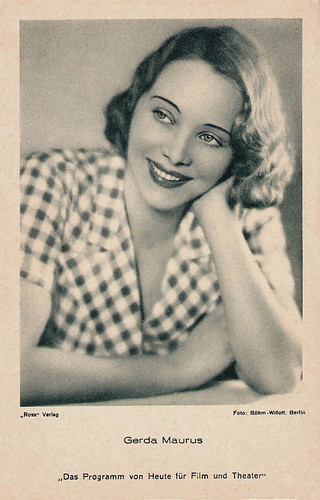
German postcard by Das Programm von Heute / Ross Verlag, Berlin. Photo: Böhm-Willott, Berlin. Collection: Miss Mertens. Austrian actress Gerda Maurus (1903-1968) was a star of the silent screen. With her protruded cheekbones and her forceful look, she bewitched many men, including her director Fritz Lang and Nazi Minister Josef Goebbels.

German postcard by Das Programm von Heute / Ross Verlag. Photo: Tobis. Sexy German dancer and film actress La Jana (1905-1940) was the most popular showgirl in Berlin in the 1930s. She appeared in 25 European films, often dancing in exotic costumes. In 1940, she suddenly died of pneumonia and pleurisy.
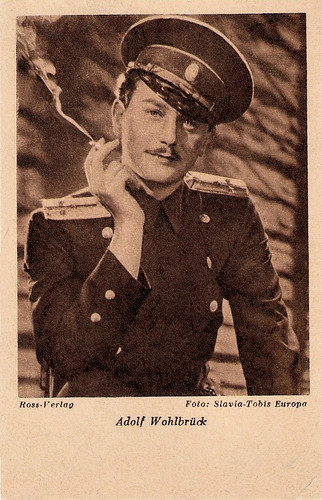
German postcard by Das Programm von Heute / Ross Verlag. Photo: Slavia - Tobis Europa. Adolf Wohlbrück in Port Arthur (Nicolas Farkas, 1936). Dark and handsome Adolf Wohlbrück (1896-1967) a.k.a. Anton Walbrook was a distinguished Austrian actor who starred in early German sound films as Walzerkrieg (1933) and Viktor und Viktoria (1933). After the rise of Hitler, he settled in Great Britain where he appeared in such film classics as The Life and Death of Colonel Blimp (1943) and The Red Shoes (1948). He also played the ringmaster in La Ronde (1950).
The Program for Today
A 'Das Programm von Heute', Zeitschrift für Film und Theater (The Program for Today. Newspaper for Film and Theatre) was 6 pages long (2×3 (contiguous) pages), in the format of 20.5 x 25 cm (8 x 10 inch). The programs were numbered and went far above 500.
In addition to general information about each film (director, screenplay, music, sound, editing, actors, etc.), the content of the film was described in text and numerous pictures.
The series focused on German and Austrian films but also included French, Italian and American films and Hollywood stars.
The programs were published by ‘Zeitschrift für Film und Theater GmbH’ in Frankfurt/M. Sometimes Berlin or Stuttgart is given as the location of the publisher.
The programs and cards were issued between 1934 and 1939. Eventually, the programs were reduced in size, and instead of including a postcard with each edition, a facsimile of one was printed right on the cover.

German postcard by Das Programm von Heute / Ross Verlag. Photo: Hammer-Tonfilm. Gaby Morlay in Le scandale/The Scandal (Marcel L'Herbier, 1934) with Mircha and Gaby Triquet. Gaby Morlay (1893-1964) was a French actress with a long-standing career, playing in over 100 films. She compensated her small size (1.53 m.) with passion and enthusiasm.

German postcard by Das Programm von Heute / Ross Verlag. Photo: Hammer-Tonfilm. Blonde Austrian actress and singer Gretl Theimer (1911-1972) arrived in the German cinema with the sound film and had an impressive career in the 1930s.

German postcard by Das Programm von Heute / Ross Verlag. Photo: Minerva-Europa. Luise Ullrich in Viktoria/The Love of a Lady (Carl Hoffmann, 1935). Austrian actress Luise Ullrich (1910-1985) starred in many German films of the 1930s, 1940s and 1950s. No German star played self-sacrificing womanhood better than the blond actress and her film Annelie (1941), became the main morale-booster of World War II Germany.

German postcard by Das Programm von Heute / Ross Verlag. Photo: Metropolitan / Bavaria. Rolf Wanka in Rote Rosen - blaue Adria/Red Roses - Blue Adriatic (Jan Sviták, 1938). Austrian actor Rolf Wanka (1901-1982) was a handsome, suave star of the European cinema of the 1930s and the 1950s. He often played supporting parts as a well-dressed, dignified gentleman, and appeared in more than 100 films and television shows between 1931 and 1976.

German postcard by Das Programm von Heute, Berlin / Ross Verlag. Photo: Bavaria. Geraldine Katt in Die Stimme des Herzens/The Voice of the Heart (Karlheinz Martin, 1937). Geraldine Katt (1920-1995) was an Austrian actress, who was seen in romantic comedies and melodramas of the 1930s and 1940s. She appeared in more than ten films from 1936 to 1951.
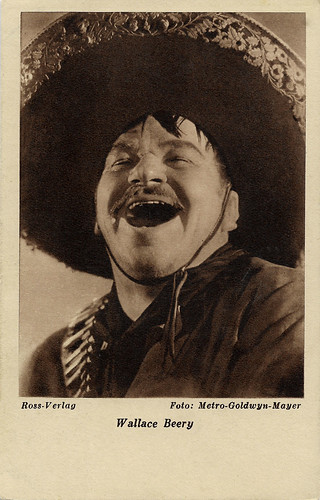
German postcard by Das Programm von Heute, Berlin / Ross Verlag. Photo: Metro Goldwyn Mayer. Wallace Beery in Viva Villa! (Jack Conway, 1934). American actor Wallace Beery (1885-1949) is best known for his portrayal of Bill in Min and Bill opposite Marie Dressler, as Long John Silver in Treasure Island, as Pancho Villa in Viva Villa!, and his titular role in The Champ, for which he won the Academy Award for Best Actor. Beery appeared in some 250 films in a 36-year career. He was the brother of actor Noah Beery, Sr. and uncle of actor Noah Beery, Jr.

German postcard by Das Programm von Heute / Ross Verlag. Photo: Fox-Film. Clark Gable in Call of the Wild (William A. Wellman, 1935). With his natural charm and knowing smile, Clark Gable (1901-1959) was 'The King of Hollywood' during the 1930s. He often portrayed down-to-earth, bravado characters with a carefree attitude, and was seen as the epitome of masculinity. Gable won an Academy Award for Best Actor for It Happened One Night (1934), and was nominated for his leading role in Mutiny on the Bounty (1935) and for his best-known role, Rhett Butler in Gone with the Wind (1939).

German postcard by Das Programm von Heute, Berlin / Ross Verlag. Photo: Badal / Terra. Pola Negri in Der Weg nach Shanghai/Moskou Shanghai (Paul Wegener, 1936). Polish film actress Pola Negri (1897-1987) achieved notoriety as a femme fatale in German and American silent films between the 1910s and 1930s. In the late 1910s and the 1920s, she achieved notoriety as a femme fatale in silent films in Poland, Berlin, and Hollywood. Negri was an overnight sensation in Ernst Lubitsch's Madame du Barry/Passion (1919). Her vamp roles were so popular that she was a direct rival of Theda Bara, and lived in a Hollywood palace, modelled after the White House.

German postcard by Das Programm von Heute, Berlin / Ross Verlag. Photo: Märkische / Panorama / Schneider. Ingrid Bergman in Die 4 Gesellen/The Four Companions (Carl Froelich, 1938). Ingrid Bergman (1915-1982) was ‘Sweden's illustrious gift to Hollywood’. In the 1940s the fresh and naturally beautiful actress won three times the Oscar, twice the Emmy, and once the Tony Award for Best Actress. Little known is that before she went to Hollywood she already had a European film career.

German postcard by Das Programm von Heute / Ross Verlag. Photo: Terra-Sandau. Georg Alexander (1888-1945) was a German actor, director and producer. He belongs to the busiest actors and his career continued smoothly till his death.
Cheaper paper
The Das Programm Von Heute postcards were made of cheaper paper than for example the Ross Verlag postcards. The cards were given away free as an insert in 'Das Programm von Heute. Zeitschrift fur Film und Theater'. The card size was 9 x 14 cm (3.5 x 5.5 inch). Over 730 unnumbered cards are known, with up to 8 different fronts and backs. The Ross Postcards website offers an overview.
The postcards were in black and white or in single-color tints. There were 5 different single-colour shades: grey-black, blue-black, brown, violet-brown and dark green. The cards were printed with "Ross Verlag" in many different styles, until the name disappeared off of the cards altogether, probably after the company was taken over by the National Socialists.
Most stars in the series are German or Austrian, but the likes of Greta Garbo, Clark Gable, Jean Harlow, Wallace Beery and Shirley Temple also get a look in, often with multiple cards. There were also French and Italian stars pictured. The young pre-Hollywood Ingrid Bergman was pictured on one of the cards when she starred in the German film Die 4 Gesellen/The Four Companions (Carl Froelich, 1938).
There were also postcard albums designed solely for storing these cards. Issued over 6 years, there were many different variations of the album. The cover was either silver, beige, or grey, with album pages yellow-white or dark grey. The album title was always in blue. Backs with either "Das Programm von Heute, Zeitschrift für Film und Theater G.m.b.H., Berlin S.W. 11, Dessauerstr. 7" or "Das Programm von Heute für Film und Theater G.m.b.H. Stuttgart".
All were slot-in albums with either 96 or (much rarer) 104 spaces. Albums with 104 spaces came in the following variations: The cover was either silver or beige, with album pages yellow-white or dark grey. The album title was either in blue or red. Backs with either "Das Programm von Heute, Zeitschrift für Film und Theater G.m.b.H. Stuttgart" or "Das Programm von Heute für Film und Theater G.m.b.H. Stuttgart". Because pages were blank, any postcard could be slotted in anywhere. You often find albums with postcards from other sources, such as Ross Verlag or Eidelstedter Margarine (Eidelsan).

German postcard by Das Programm von Heute / Ross Verlag. Photo: Tobis. Frits van Dongen in Der Tiger von Eschnapur/Das Indische Grabmal (Richard Eichberg, 1938). With this film, Van Dongen had his breakthrough as Maharaja Chandra. Handsome, deep-voiced leading man Frits van Dongen (1901-1975) was one of the first Dutch Hollywood stars. He started his film career in the Netherlands, and in the mid-1930s he became a matinee idol in the German cinema. From 1940 on, he worked in Hollywood, billed as Philip Dorn. A freak accident caused him to retire in 1955.

German postcard by Das Programm von Heute / Ross Verlag. Photo: Bavaria/Ross Verlag. German stage and film actress Heli Finkenzeller (1914-1991) had her greatest successes in popular Ufa comedies of the 1930s and 1940s. After the war, she often played mother roles.
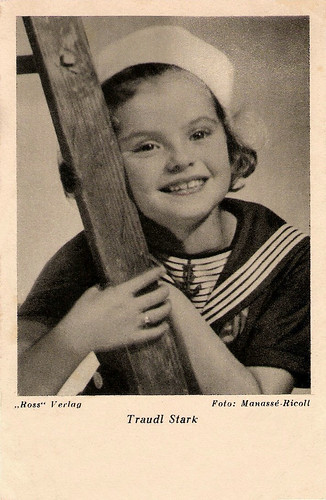
German postcard by Das Programm von Heute / Ross Verlag. Photo: Manassé-Ricoll. Austrian child actress Traudl Stark (1930-2021) was the Shirley Temple of the German cinema. Between 1935 and 1940, she made a dozen popular films in Austria. After the war, she married, left the film industry, and moved to the USA. Gertraud 'Trudy' South passed away in Tampa, Florida, where she resided since 1973.

German postcard by Das Programm von Heute / Ross Verlag. Photo: Meteor / Tobis. Ruth Hellberg in Yvette (Wolfgang Liebeneiner, 1938). During the 1930s and 1940s German actress Ruth Hellberg (1906-2001) appeared in several films of her husband Wolfgang Liebeneiner. After their divorce, she focused on her stage career.

German postcard by Das Programm von Heute / Ross Verlag. Photo: Terra-Baumann. Ethereally blonde Camilla Horn (1903-1996) was a German dancer and film star. Her breakthrough role was Gretchen in Friedrich Wilhelm Murnau's silent film classic Faust (1926). She also starred in some Hollywood films of the late 1920s and a few British and Italian productions.

German postcard by Das Programm von Heute / Ross Verlag. Photo: Tobis-Majestic (Wunsch). Gustaf Gründgens as Debureau in Tanz auf dem Vulkan/Dance on the volcano (Hans Steinhoff, 1938). Gustaf Gründgens (1899-1963) was one of the most famous and influential but also controversial German actors and artistic directors of the twentieth century. He launched himself as a comet during the Weimar Republic. His most beautiful role was Mephisto, the devil in Goethe's 'Faust'. With that role he celebrated triumphs. His best-known film role was the criminal 'Der Schränker' (The Safecracker), the chief judge of Peter Lorre's character in Fritz Lang's M – Eine Stadt sucht einen Mörder/M (1931). After 1933, Gründgens became the stage favourite of the Nazi top. Although Reich Propaganda Minister Joseph Goebbels hated the homosexual Gründgens to the bone, Field Marshal Hermann Göring protected him personally. In 1946, Gründgens again acquired an important position in the German theatre. He triumphed in Berlin, amidst returned exiles and survivors from the concentration camps and was again respected as an actor.
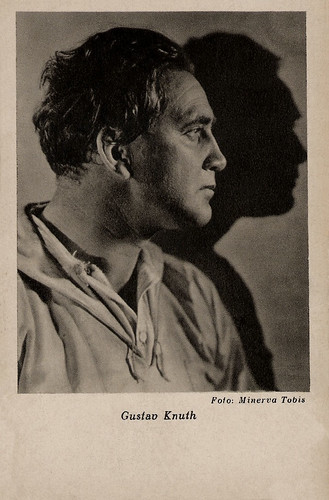
German postcard by Das Programm von Heute, Berlin. Photo: Minerva / Tobis. Gustav Knuth in Heimweh/Homesick (Jürgen von Alten, 1937). Gustav Knuth (1901-1987) was a German actor who played folksy, good-natured characters in numerous films and TV series. After the Second World War, he took Swiss citizenship. He was a successful stage actor and starred in more than 120 films between 1935 and 1982. During the 1960s and 1970s, he was one of the most distinguished German TV actors.

German postcard by Das Programm von Heute / Ross Verlag. Photo: Baumann / Terra. Ernst von Klipstein (1908-1993) was a rangy, masculine German supporting actor and occasional lead. He performed on stage from 1925. Von Klipstein became a prominent actor during the Nazi era, mainly for Universum AG (Ufa) where he was often cast as an officer, chief engineer or other authority figure. After the war, he was much in demand for synchronising work, radio plays and as a guest star on TV.

German postcard by Das Programm von Heute / Ross Verlag. Photo: Tobis / Brix. Hans Albers in Trenck, der Pandur/Trenck, Officer of the Pandurs (Herbert Selpin, 1940). Jovial, pleasantly plump Hans Albers (1891-1960) was a superstar of German cinema between 1930 and 1945. He was also one of the most popular German singers of the twentieth century. His song 'Auf der Reeperbahn nachts um halb eins' (On the Reeperbahn at half past midnight) is the unofficial anthem of Hamburg’s neighbourhood of St. Pauli, famous for its brothels, music and nightclubs.

German postcard by Das Programm von Heute / Ross Verlag. Photo: Baumann/Terra. Heinrich George in Jud Süss/Jew Süss (Veit Harlan, 1940). Huge, bear-like Heinrich George (1893–1946) was a famous German stage and film actor of the Weimar Republic. He starred in such classics as Metropolis (1926) and Berlin Alexanderplatz (1931). Under the Nazi regime, the former Communist was initially not permitted to work but later appeared in notorious Propaganda films such as Jud Süss (1940). After the war, he died of starvation in a Soviet concentration camp.
Sources: Thoralf Haß (Käthe von Nagy – German), Troy Kirk (The Movie Card Website), and Ross Postcards.
With thanks to Jean Ritsema and Ivo Blom! Our Ross Verlag Tribute will be continued next week and please, remember to check out the Ross Verlag Movie Stars Postcards website.
No comments:
Post a Comment